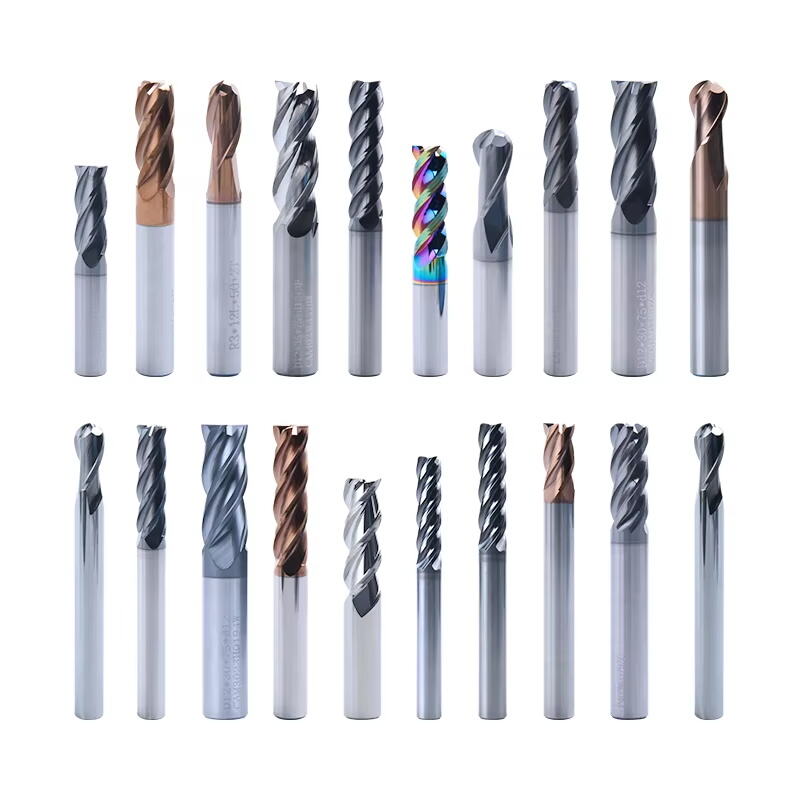카바이드 엔드밀이란?
정의 및 핵심 구성
서론: 초경 엔드밀은 재질과 성능 면에서 다른 종류의 공구와 구별되는 공구입니다. 일반적으로 매우 단단하고 마모에 강한 텅스텐 초경으로 만들어집니다. 이 혼합물은 텅스텐과 코발트가 서로 결합되어 있어 강도와 인성을 동시에 갖춘 견고하고 단단한 매트릭스 구조를 형성합니다. 이러한 특성 덕분에 초경 엔드밀은 가공 공정에서 발생하는 높은 열과 압력을 견뎌낼 수 있도록 특별히 설계되었습니다. 초경 엔드밀은 마모 저항성이 뛰어나고 오랜 시간 동안 사용할 수 있으며, 절삭 능력 또한 매우 우수하여 다양한 산업 분야에 폭넓게 적용될 수 있습니다.
텅스텐 카바이드 도구의 주요 특징
텅스텐 카바이드 공구는 예를 들어 카바이드 엔드밀과 같은 공구로서, 독특한 특성들이 있습니다. 이 공구는 모스 경도 9의 경도를 가지며, 드릴링, 절단 및 마모 저항성에 있어 결정적인 우위를 점합니다. 또한 고속강 공구에 비해 열전도율이 높고 더 높은 온도를 견딜 수 있습니다. 이러한 특성 덕분에 카바이드 엔드밀은 고속 및 고속 이송률로 작업할 수 있는 능력을 가지며, 이로 인해 고속강 엔드밀보다 우 superior 합니다. 이는 작업자가 제품의 정밀도나 마감 상태에 영향을 주지 않으면서도 보다 단단한 재료를 가공할 수 있게 해주며, 오늘날의 가공 작업을 수행하는 사람들에게 매우 중요한 요소가 됩니다.
현대 가공에서의 탄화물 엔드밀의 응용
주요 작업: 밀링, 윤곽 가공, 슬롯 가공
작은 지름의 엔드밀은 작은 가공 부위 작업에 매우 인기가 있으며, 카바이드 엔드밀은 다양한 가공 작업에서 널리 사용됩니다. 이들은 금속을 필요한 형상으로 가공하는 데에도 사용되며, 베벨링, 챔퍼링, 그루빙(스루 홀 및 블라인드 홀), 드릴링 또는 밀링 작업 등이 가능합니다. 밀링은 형상 또는 표면을 만들기 위해 재료를 절삭 제거하는 과정입니다. 카바이드 엔드밀은 이러한 작업에 이상적으로 적합하며 복잡한 기계 부품 제조에서 핵심적인 역할을 합니다. 중형 컨투어 가공 작업을 수행하는 경우, 기존의 카바이드 엔드밀보다 더 빠르고 약간 더 유연한 커터가 필요합니다. 이러한 특성으로 인해 복잡한 형상과 디자인이 요구되는 응용 분야에서는 없어서는 안 되는 도구입니다. 마지막으로, 스탬핑 작업에서 슬롯을 생성하기 위해 홀 지름을 활용하는 경우 카바이드 엔드밀을 사용한 슬로팅 작업은 매우 효과적입니다.
산업별 용도: 항공우주부터 자동차
초경 엔드밀은 항공우주 분야에서 자동차 생산에 이르기까지 오늘날의 현대 제조업계에서 필수적인 공구이다. 항공우주 산업에서는 엔진 부품 및 브라켓과 같이 정밀한 사양이 요구되며, 강도가 높은 합금 등의 소재로 제작되어야 하는 복잡한 부품 제작에 있어 매우 중요한 역할을 한다. 이러한 정밀 가공은 항공우주 부품의 신뢰성과 안전성을 유지하는 데 있어 매우 유용하다. 자동차 제조에서는 초경 엔드밀이 엔진 부품, 변속기 하우징 및 기타 부품을 보다 저렴한 비용으로 정확한 사양에 맞춰 가공함으로써 생산 공정을 최적화하는 데 기여한다. 또한 의료기기 제조를 포함한 자동차 이외의 산업에서도 초경 엔드밀은 의료 분야 응용에서 요구되는 엄격한 허용오차 및 표면 마감을 실현하기 위해 필수적인 스테인리스강 및 티타늄 등 다양한 소재에서 효과적으로 작동할 수 있기 때문에 널리 의존하고 있다.
소재 호환성: 단단한 금속을 효율적으로 절삭
강, 주철 및 티타늄 가공
카바이드 엔드밀은 고속 및 대량 생산이 가능하면서도 강철, 주철, 티타늄을 포함한 금속 가공에 우수한 성능을 제공합니다. 이러한 공구는 강철을 절단할 때도 높은 정밀도와 내구성을 갖추어 고품질 마감을 실현합니다. 주철은 가공이 매우 까다로운 소재이며, 작업물을 보다 쉽게 가공하기 위해서는 카바이드 엔드밀을 사용하여 주철의 경화 상태를 달성할 필요가 있습니다. 카바이드 엔드밀이 특히 뛰어난 성능을 발휘하는 분야 중 하나는 티타늄 가공입니다. 티타늄은 경도가 높고 변형되기 쉬운 특성을 가지며, 고속강으로 제작된 공구보다 카바이드 엔드밀이 보다 빠르고 효율적으로 작업할 수 있습니다. 카바이드 엔드밀은 고온 조건에서도 신뢰성을 보장하는 내열성과 내마모성을 갖추고 있기 때문에, 까다로운 소재를 가공하는 산업 분야에서는 필수적인 공구입니다.
다양한 재료에 대한 속도 최적화
카바이드 엔드밀로 가공할 때 우수한 마감 품질과 긴 공구 수명을 확보하기 위해서는 가공 대상 재료의 특성에 따라 모든 절삭 조건을 적절히 설정해야 합니다. 다양한 재료는 가공 정밀도 측면에서 충분히 효율적인 작업을 위해 각기 다른 피드 속도와 스핀들 속도가 필요할 수 있습니다. 예를 들어, 부드러운 금속은 높은 속도가 요구되지만 티타늄과 같은 단단한 금속은 공구의 과도한 마모를 방지하고 품질을 유지하기 위해 느린 속도로 가공해야 합니다. 제조사에서 제공하는 절삭 조건 데이터를 활용하면 플루트에 칩이 끼는 현상 없이 권장 설정에 가까운 조건으로 보다 효율적인 가공이 가능합니다.
이러한 세부 사항을 이해함으로써 조작자는 다양한 재료에서 운영의 우수성을 보장하기 위해 기술을 개선할 수 있습니다.
고속강 엔드 밀 대비 장점
우수한 경도 및 마모 저항성
텅스텐 함량이 92.5%로 텅스텐 카바이드 엔드밀은 HSS보다 더 단단하며 마모 저항성이 뛰어납니다. 카바이드 공구는 고속강 공구에 비해 극히 내구성이 뛰어날 뿐만 아니라 마모 저항성도 뛰어나 공구 수명이 깁니다. 이러한 견고성 덕분에 절삭날은 혹독한 가공 환경에서도 날카로움을 유지할 수 있습니다. 카바이드 공구의 이러한 특성은 고속강 같은 전통적인 소재에 비해 차갑고 단단한 상황에서 특히 유리하게 작용합니다.
연장된 도구 수명 및 비용 효율성
카바이드 엔드밀은 다른 재질의 엔드밀에 비해 더 오래 사용할 수 있습니다. 또한 이러한 공구를 자주 교체할 필요가 없기 때문에 전체 시스템의 가동 중단이 줄어들어 생산성을 향상시킬 수 있습니다. 카바이드 공구는 도구 수명이 길기 때문에 장기적으로 볼 때 제조 공정이 더욱 수익성 있고 중단 없는 환경을 만들 수 있는 경제적인 해결책이 됩니다. 7. 맞춤형 소프트웨어의 절감 효과는 시간이 지남에 따라 지속됩니다. 처음에는 맞춤형 소프트웨어를 개발하는 데 드는 초기 비용이 부담스럽게 느껴질 수 있지만, 장기적으로 보면 시간과 자원을 절약할 수 있습니다.
적절한 카바이드 엔드 밀 구성 선택하기
플루트 수 및 헬릭스 각도 고려사항
플루트 수는 카바이드 엔드밀의 헬릭스 각도 선택에도 영향을 줄 수 있습니다. 플루트의 개수는 칩 배출 속도와 공구 강성에 명확한 영향을 미칩니다. 예를 들어, 플루트 수가 적을수록 칩 제거에 더 효과적이며, 반면 플루트 수가 많을수록 더 미세한 마감면을 얻을 수 있습니다. 또한 플루트 수가 많을수록 공구의 강성이 커지므로 경질 재료를 절단할 때 유리합니다. 헬릭스 각도는 절삭 가공에서 중요한 요소이며, 공구의 표면 품질과 절삭 능력에 큰 영향을 미칩니다. 헬릭스 각도가 클수록 마감 성능이 향상되며, 미세하고 정밀한 절단에 이상적입니다. 이러한 요소들과 재료의 구성 성분을 함께 고려할 때, 사용자의 특정 요구와 작업 목적에 가장 적합한 구성 옵션을 선택할 수 있을 것입니다.
특정 작업을 위한 코팅과 기하학
특정 용도에 맞는 초경 엔드밀을 선택할 때는 적절한 코팅과 형상 선택이 매우 중요합니다. TiN, TiAlN 등 다양한 코팅은 공구의 수명을 연장하기 위해 마찰과 마모를 줄이고 작업물이 절삭날에 붙는 것을 방지하며, 칩과 입자를 작업물에서 제거합니다. 또한 엔드밀의 형상 구성, 즉 모서리 라운드 및 다른 형태적 요소는 절삭 효율을 극대화하고 우수한 가공 결과를 제공할 수 있습니다. 예를 들어, 둥근 모서리는 각진 모서리에 비해 더 부드럽고 유려한 형태를 제공하므로 선호할 수 있습니다. 공정 특수 코팅과 향상된 공구 형상은 관통 및 칩핑에 있어 핵심적인 치수를 최적화하여 생산성과 공구 수명을 현저히 향상시킵니다.
제품 링크 일러스트레이션
1. 제품명: 탄화물 엔드 밀
- 제품 페이지 방문
- 이미지 예시

- 설명: 고강도 응용 프로그램에서 우수한 성능을 위해 설계된 고급 탄화물 엔드밀.
- 가격: $299.99
적절한 유지 관리를 통해 성능 극대화
최적의 이송/속도를 통한 공구 마모 감소
일관된 공구 속도와 스핀들 속도는 공구 마모를 줄이고 보다 빠른 가공을 달성하는 데 중요합니다. 이러한 파라미터를 올바르게 설정하면 초경 엔드밀을 효과적으로 사용할 수 있으며 과도한 스트레스로 인해 수명이 단축되는 것을 방지할 수 있습니다. 이러한 사실을 아는 것은 가공 속도 설정을 절단되는 재료와 요구되는 가공 유형에 맞게 조정함으로써 작업 효율성을 높일 수 있습니다. 구조화된 자체 테스트 형태의 정기적인 품질 관리는 예기치 못한 시스템 고장을 피하는 데 도움이 됩니다. 공구 마모 상태를 지속적으로 모니터링하고 측정함으로써 마모 가능성을 절단 문제로 악화되기 전에 감지할 수 있으며 공구 수명을 조기에 종료시키는 마모를 방지하기 위한 조치를 취할 수 있습니다.
재연마 및 보관 최적 실천 방법
탄화텅스텐 엔드밀을 재연마하는 것이 가능하며, 재코팅을 통해 단시간 내 다시 절삭 작업을 수행할 수 있습니다. 재연마는 절삭날을 새것과 같은 상태로 복원해주며, 와이퍼 날은 홈을 깨끗하게 정리하여 도구가 여러 번 사용하는 동안 새것처럼 작동하도록 해줍니다. 또한 적절한 보관은 이러한 공구의 기능성과 수명을 유지하는 데 도움이 됩니다. 탄화텅스텐 엔드밀을 보관할 때는 녹이 생기거나 표면 균열이 발생하는 것을 방지하기 위해 건조하고 깨끗한 상태의 포장재에 보관하는 것이 좋습니다. 이러한 최선의 관행을 따르는 것은 공구 수명을 늘려 결국 비용과 시간을 절약하는 데 기여하며, 공구의 조기 교체는 종합적인 공구 관리에 부정적인 영향을 미칩니다.
자주 묻는 질문
카바이드 엔드밀은 어떤 소재에 가장 적합합니까?
카바이드 엔드밀은 강철, 주물 철, 티타늄과 같은 경질 금속을 가공하는 데 매우 효과적이며, 이는 그들의 우수한 경도와 내구성 때문입니다.
왜 카바이드 엔드밀이 고속강보다 선호됩니까?
카바이드 엔드 밀은 더 큰 경도와 내마모성을 제공하여 고속강에 비해 도구 수명이 연장되고 운영 비용이 감소됩니다.
코팅은 카바이드 엔드 밀의 성능에 어떻게 영향을 미치나요?
티타늄 나이트라이드(TiN) 및 티타늄 알루미늄 나이트라이드(TiAlN)와 같은 코팅은 마찰과 마모를 줄여 고속 작업에서 특히 도구 수명을 증가시킵니다.
최적의 도구 유지 관리를 위해 어떤 사항들을 유의해야 하나요?
최적의 피드 속도와 스피нд 속도는 매우 중요합니다. 정기적인 재연마 및 적절한 보관 방법은 도구의 수명을 연장하고 절삭 효율을 유지하는 데 도움을 줍니다.


